2.3.1.1 Sheet quality
For the manufacture of stainless steel rectangular air ducts, generally speaking, sheet of the quality X 5 CrNi-18-10-1.4301 according to NEN-EN 10088-2 (AISI 304) is used. For specific applications stainless steel in the quality X 5 CrNi-18-10-1.4404 according to NEN-EN 10088-2 (AISI 316) can be applied.
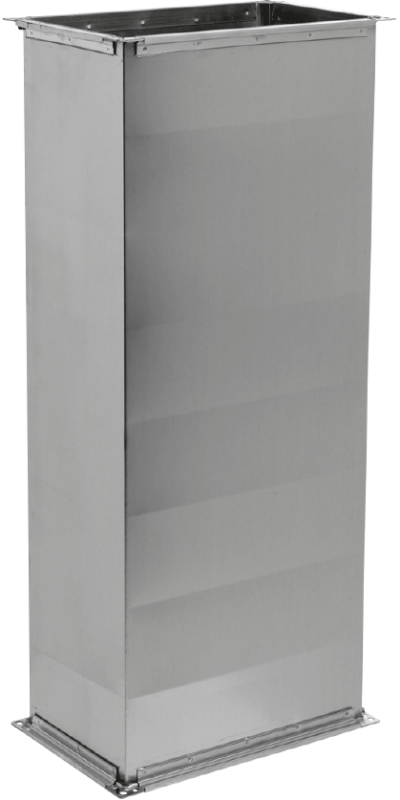
2.3.1.2 Sheet thickness
Stainless steel air ducts are manufactured in a thickness depending on the largest duct size as specified below. For these thicknesses the air ducts are manufactured in such a way that sufficient stiffness against deformations and troublesome vibrations is provided. Starting from the largest duct side, the minimum sheet thickness is

For technical reasons, thicknesses greater than 1.00 mm are avoided.
2.3.1.3 Cross-connections
In rectangular air ducts, different types of cross-connections can be used. These are company specific, whereby the quality of the sheet from which the connecting profiles are formed at least corresponds to that of the material from which the duct is made. These cross-connections may (depending on the company) be rolled to the duct or fastened to the duct by means of push-throughs, spot-welds, parkers or pop rivets. The cross-connections are connected with clips, sliding strips or clamps with a maximum centre-to-centre distance of 500 mm (see illustration). The fasteners are made of stainless steel. A closed cell sealing tape is applied between the cross-connections in order to ensure airtightness; the minimum dimension B x H = 18 x 4 mm and all four corners must be fitted with stainless steel bolts and nuts, M 6 x 20 minimum. If sliding strips are used for the full circumference of the duct, the bolts and nuts at the corners can be omitted. Where necessary, plastic sealant will be applied internally or externally to ensure airtightness.

2.3.1.4 Longitudinal connections
Longitudinal connections between duct sections are generally made using a flange connection. Where necessary, plastic sealant is applied internally or externally to ensure airtightness.
2.3.1.5 Stiffening
Air ducts shall be of such a stiffness that troublesome vibrations and deformations do not occur. Assuming application of the recommended minimum sheet thicknesses according to 2.3.1.2, this applies to rectangular metal ducts if the largest side of the cross section is ≤ 400 mm. If this dimension is exceeded, additional provisions are required. The extent of the exceedance determines the type of execution of the provisions.
For ducts with a side length of > 400 and ≤ 800 mm, the execution forms are for the respective duct wall surfaces:
- Cross-breakings: normal outward facing cross-breakings;
- rills or offsettings: generally arranged transversely to the longitudinalaxis of the duct, at intervals not exceeding 500 mm.
For ducts with a side > 800 mm, the previously mentioned types of implementation apply for the duct wall surfaces concerned, whereby surfaces with a surface area greater than 1.5 m² are additionally stiffened by subdividing them in sub-areas not exceeding 1 m². This additional stiffening in the form of strips, profiles, pipes or sheets are applied internally or externally.
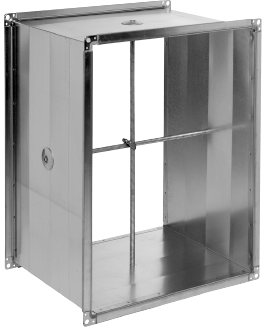
2.3.1.6 Dimensions
The nominal sizes of the air ducts are given in mm and refer to the internal dimensions with a tolerance of +0 to -4 mm. The dimensions are standardised according to NEN-EN 1505 and can be selected as indicated in the table for standard dimensions.
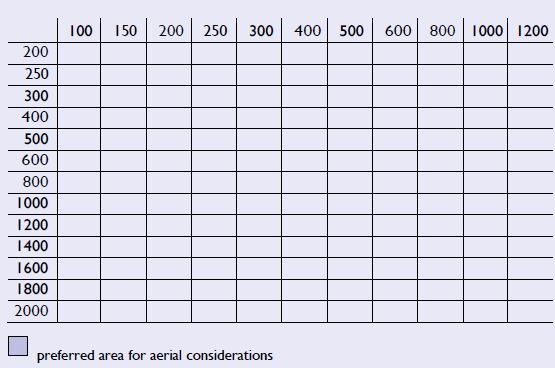
2.3.1.7 Visible work
If in an air technical installation a part of the air duct system has to be executed as "visible work", this will be executed as the other duct work, unless it has been mentioned otherwise in the specifications. In the case of duct work qualified as visible work, externally applied stickers and indications shall be removed, while the required airtightness shall be obtained by internal sealing. Additional measures within the framework of visible work do not normally belong to the standard execution.
2.3.1.8 Bends
Symmetrical bends
As regards form, symmetrical bends are in principle executed in a round shape, i.e. with an inner and an outer radius; (in the case of floor or wall recesses where there is no room for an inner radius, an angled inner bend may be used or for production reasons); the inner radius is 100 mm or greater. In order to limit the resistance in a bend, bends are provided with blades. No blades are used for:
- bends of 45° or less;
- ducts with a width of 400 mm or less.
The position of the blades shall be determined according to the table below.

Elongated bends
In the case of elongated bends, the smallest duct width determines the number of blades, in accordance with the table above. The ratio for the position of the blades of the largest duct width is then equal to the ratio for the blades of the smallest duct width.
Blade design
The blades are made of single sheet metal. The sheet material is the same as the material from which the duct is made. The design and
fixing are of sufficient strength, while the ends of the blades are stiffened.
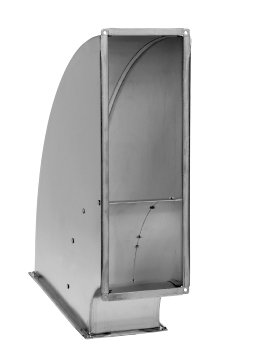
2.3.1.9 Adapters
Adapters are made in such a way that the top angle α of the adapters may not exceed 60°.
2.3.1.10 Branches
A branch (split off from a continuous main duct) can be achieved by means of a flowing fitting in a rectangular or round design. Aerodynamic aspects also determine the types, as shown in the illustrations below.
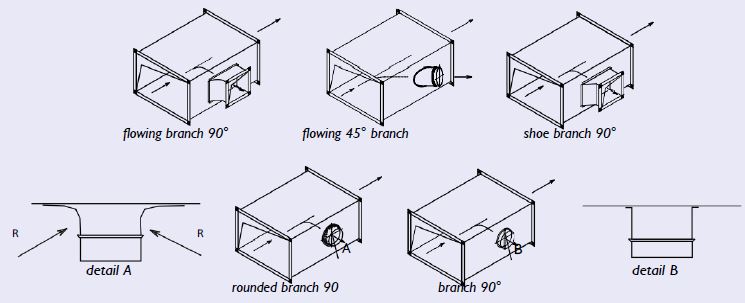
2.3.1.11 Splits
A split is a division of a main duct into two ongoing ducts.
Some examples of splits are:
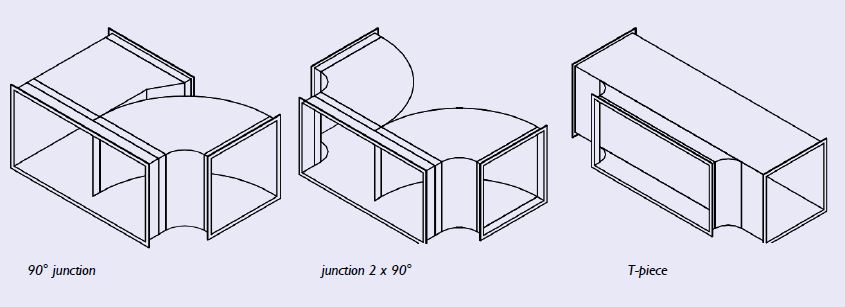
2.3.1.12 Adjustment valves
Adjustment valves are manually adjustable and serve to regulate an installation. They are provided with an appropriate locking device which also indicates the valve position. The damper blade, of the same material as the air duct, is executed in a single sheet with a thickness of at least 0.8 mm (executed according to the drawing below) up to a maximum blade width (B) of 300 mm and up to a maximum surface of 0.09 m². The edges of the damper blades are rounded and stiffened parallel to the axial direction.
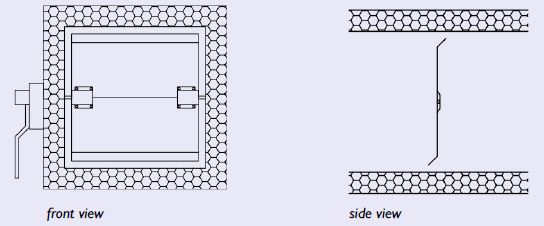
2.3.1.13 Tolerances
The maximum tolerance for the length of a straight duct is ± 0,005 x L.
The tolerance for rectangular dimensions is + 0 to - 4 mm. The maximum tolerance for corners is ± 2° and stiffened.

